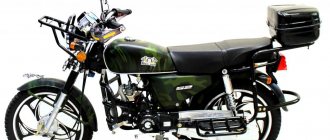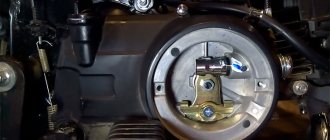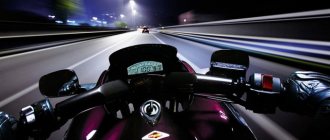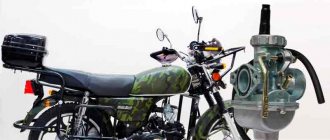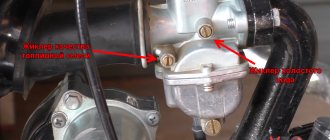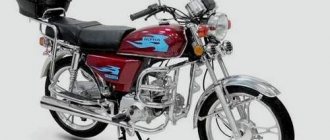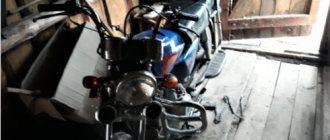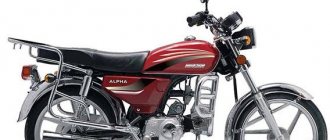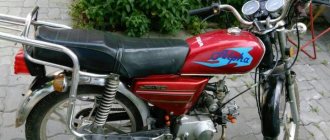The Alpha moped is one of the most popular in the post-Soviet countries. This is not surprising, because this model is excellent value for money. The characteristics allow us to consider the moped practically a universal one, and the wide possibilities for modification help to significantly expand them. The use of such a moped is not only convenient, but also economical - fuel consumption per 100 km is only about 2 liters with a factory equipped engine. The combination of low weight (about 80 kg) with a load capacity of up to 120 kg makes this model very attractive.
However, used models sometimes experience problems with ignition, which negates all the advantages of the moped. It’s not very difficult to get your iron horse back into service and understand why the Alpha moped won’t start. To do this, it is not even necessary to contact specialists - with due attention, all the work can be done with your own hands.
Alfa moped wiring diagram: features of domestic operation
The classic look of the Alpha moped.
Of particular interest is the ALPHA moped with an air-cooled engine, which is sold in the Russian Federation as “Alpha 110cc” or “Alpha 49”. The numbers in the name indicate the engine displacement:
- 49 cc four-stroke air-cooled engine. cm, power 4.5 hp;
- 110 cc four-stroke air-cooled engine. cm, power 7 hp.
Mopeds, due to their external resemblance to motorcycles, differ from scooters, although they represent a separate class. However, the combination of technical parameters, ease of do-it-yourself maintenance and low operating cost have made this moped a sales leader on the Russian motorcycle market.
For reference: in China, several manufacturers assemble the ALPHA model. Among them are Horse, Chong Qing Bull, WONJAN, Omaks and a number of others. Companies such as AVM and SMoto also assemble mopeds in Russia. At the same time, the wiring diagram of the Alpha moped is identical, regardless of the location of assembly.
Tuning the Alpha moped: improving performance and increasing speed
For every moped owner, sooner or later there comes a time when you want to improve your equipment. From the appearance - decorate with LEDs, reflectors and stickers to highlight your individuality, to increasing speed in traffic and reducing travel time. Both external and internal tuning and improvement is a painstaking and thoughtful task. And once you start it, you can immerse yourself for a long time...
Unusual tuning of the alpha moped
Your imagination will tell you how to decorate a moped, but how to accelerate it to the desired speed is a question that requires a constructive approach.
Appearance of Alpha RX
Alpha RX is an updated version of the previous classic moped. The new moped has become more interesting and elegant in appearance. The exterior has a modern look which I liked. The tank has been updated, a two-level seat has been installed - the passenger is now slightly higher than the driver. The passenger's visibility is now better. The wings are now made of plastic, but only the front wing is painted. This already saves the wings from corrosion.
The headlight became larger than that of the classic Alpha, a serious halogen lamp was installed, and the light became brighter. The rear shock absorbers have become more advanced in shape. The motorcycle is also equipped with serious lighting equipment - front and rear lights, turn signals with sound, high and low beams, a signal and a brake light.
Very easy to use. Repair is possible with a minimum set of tools, but you will have to stock up on additional open-end wrenches: 9, 11 and 15.
It comes in two versions for sale: with a 72 cc and 110 cc engine. But lately they have been supplied partially unserviceable with a 50cc piston that will need to be upgraded. These versions of the models are called Alpha 7 and Alpha 11.
These numbers are deciphered as follows:
- 7 is an Alpha, which after modification will become a 72 cc model.
- 11 is the Alpha, which will become a 110 cc model.
Initially, these models cost like “fifty dollars” and they will not be able to drive. In any case, they will have to be modified. But according to the documents, they are like mopeds with 49.9 cubic meters and there is no need to register them with the traffic police. The only thing you need is a driver's license of any category.
Engine tuning
First of all, a moped is a vehicle. Therefore, you need to start tuning the Alpha with the engine. Correct modification can increase the power by almost 2 times.
Increasing engine volume
Initially, the engine volume is 50 cubic cm. If necessary, you can replace the engine and increase its volume to 110 cm. Such measures will require registration of the vehicle, but at the same time the engine power increases significantly. When tuning the engine of an Alpha moped, you can immediately get rid of the low-quality pistons that usually come included.
The simplest would be to install a 72cc cylinder. It will allow you to “boost” the engine by almost one and a half times. Moreover, its replacement does not require complete disassembly of the engine.
By installing the engine at 110 cubic cm, you can get the maximum speed that the moped is capable of. With such power, it will already be more of a motorcycle than a light vehicle. Expanding the volume to such figures will require complete disassembly of the moped.
When replacing the cylinder, you can pay attention to parts from the Delta or Active models. But using parts from another model will require installing not only a new cylinder, but also a crankshaft, chain, seals, rollers and even, quite possibly, a carburetor.
Replacing sprockets
To improve engine efficiency, you can replace the sprocket. This may result in increased speed. For example, according to reviews from other users, replacing a sprocket with a 15-tooth one has virtually no effect on increasing speed. That is, to get a tangible result, you should try installing a 16-tooth sprocket in combination with an enlarged cylinder.
Important: When replacing the front sprocket, you must also check the condition of the chain and rear sprocket. A worn chain causes accelerated wear on the sprockets.
Switch replacement
Alpha tuning can be done by replacing the switch. When selecting this component, it is important to pay attention to the ignition timing generator (ignition timing generator). Alas, there are practically no such switches specifically for Alpha and it is very difficult to find them. The solution is to use a switch from four-stroke Chinese mopeds - it is ideal for tuning an Alpha moped with your own hands.
JavaScript is disabled in your browser
Today, modern mopeds are equipped with a huge number of different electronic devices, which naturally operate using electricity. Whatever one may say, even a rechargeable battery needs current, so it requires periodic charging. Optics, battery, starter, tail lights and other electronic devices depend on the generator. The scooter's generator plays a major role in the correct operation of the moped, and the simplicity of its design should be like the ABCs even for novice motorcyclists. After all, this is classical physics - a school curriculum!
The moped generator is a simple flywheel magdino. Electric current is supplied directly to consumers during the rotation of the crankshaft, or more precisely during operation of the power plant. When the flywheel and magnets rotate, electricity is generated. A special charging coil is located inside the flywheel. The magnetic field oscillates in the coil itself, which leads to voltage indication.
A scooter's generator produces only alternating current, but some moped devices require direct current. For example, the battery is charged only with direct current. Let's figure out together how direct current differs from alternating current?
Engine Specifications
The moped is equipped with a 4-stroke air-cooled engine marked 1P39FMB. The marking means that the engine has a piston with a diameter of supposedly 39 mm and the engine has a volume of supposedly 49.9 cubic cm.
The advantage of such an engine is that there is no need to mix gasoline and oil. But unlike a 2-stroke engine, which is structurally simpler, here you need to monitor the valve clearance. Plus, the engine is equipped with an oil pump, a drive chain and a chain tensioner.
The gearbox on the Alpha RX moped is four-speed, like on the Voskhod motorcycle. But the neutral position is between first and second gears. The first gear is down and the rest are up.
900 ml of engine oil is poured into the engine crankcase. Oil can be filled with 10W-40. After riding the moped for 100 kilometers, I drained the factory oil and filled it with Zic engine oil. As soon as I complete the break-in, I will fill in more expensive Motul oil.
The moped is equipped with an electric starter, which can be used to start the engine by pressing a button on the steering wheel. The thing is convenient, but if the moto sits for a long time without recharging, the battery runs out. You have to start it using the kickstarter, which is located on the right side of the moped.
Kickstarter is not conveniently located. It gets in the way when driving. Therefore, it must be installed at an angle, and not vertically! The kickstarter stroke becomes shorter, but it is enough to start the engine and it does not interfere.
I installed the kickstarter at the angle shown in the photo below. For me this is the best option.
The Alpha RX moped is equipped with a PZ 19 carburetor, which has no suction. Inside there is a throttle valve with a needle on which there are 5 marks. Two idle speed adjustment screws are installed. This is a quality screw and a quantity screw. Plus there is a lever that blocks the access of air to the carburetor.
How to increase the power of the generator on an alpha delta alpha moped
Mamai Babaev
2 months ago Hello! It turned out that there was a problem with the battery draining when driving with the lights on outside the asphalt on a dirt road. I finally finished restoring the Alpha, although the summer was already over, and started running it in, but in order not to just cut circles, I decided to go fishing at the same time. It was necessary to drive fifty kilometers on asphalt and twenty kilometers on dirt roads—seventy in total. I left on August 22 at 3 am and drove in the cold at half throttle. Stars 14/41 - rushes like a tank. The light is very powerful, I especially liked the distant one - nice elongated in the form of a drop. I drove about fifteen kilometers from the city and on a long, protracted mountain the piston “seized.” I stood there, cooled down and drove not too fast, stopping to cool down every 5-7 kilometers. Despite the morning “dubak” the engine got very hot. This means that when boring the cylinder, I was greedy and made a small gap, but the piston smoothly lowered under its own weight when checking on the table. Maybe because the intake and exhaust in the head were increased and the channels around the valves were bored out, the engine began to burn more fuel and therefore the usual clearances are no longer suitable. In general, the sun had already risen, I was tired of “puking” and I decided, while it was not too hot, to speed up and finally get to the place. But fortunately there were no more “sticks”, the asphalt went better and I kept tightening and tightening. I reached the exit onto a country road and let it cool down again as the engine was very hot and there was a strong smell of burnt iron. But, as it turned out, it was my new muffler that burned out. Once I increased the release in the head from 19 to 23 mm. It was necessary to enlarge the muffler, which I made from the Karpatovsky pipe, which is larger than the Alfovsky and Karpatovsky muffler with a homemade enlarged “flute” and the sound became like that of the IZh PS. (I don’t even know how traffic cops will react to this exhaust, try and prove that you have “fifty dollars”). The poor Carpathian pipe had never experienced such temperatures in its life and first turned blue, then yellowed and turned golden. Further along the dirt road you won’t accelerate much and drove all the time at a calm pace, from time to time lowering the idle speed with the quality screw. I always started it with a kick because the battery was weak and couldn’t handle this compression. In general, I also got lost and could not find the right road to the river among the corn fields, always ending up in damp copses. But the engine no longer grabbed, but ran faster and faster. I drove back in the heat and wind, but the engine coped perfectly and on the fourth it flew up any hill. In just 150 kilometers it was only necessary to tighten a new chain. The next day off, I decided to continue running in along with fishing, and when I arrived in the garage in the dark, I discovered that my battery had “died” and couldn’t even handle the gear numbers. Didn't understand? I thought it was 150 km. It recharged normally, but it didn’t charge at all, although before that it held the charge well. Well, okay, I think, with such a scheme of two light coils, I can go fishing even without a battery, although now closer. After the trip I decided to find the problem and first recharge the battery. To my surprise, it turned out to be drained to zero in the literal sense of the word - not a single LED out of five lit up on the charger. I decided to check whether the battery was charging at all, started the engine - there was charging - 15 Volts! stable. I checked the ignition switch - the circuit opens - no short circuit. I started it again and turned on the lights, and then everything became clear. The network voltage at idle with the low beams on dropped to 5! Volt. I crashed - the voltage rose to fifteen and again to 5-7 Volts at idle. It turns out that while I was driving around at half throttle with resets for about three hours on primers, the battery supported the Zhiguli light bulb as best it could, and since I wasn’t driving on the asphalt at full throttle, it didn’t have time to charge. Now we have to think, what to do about it? For now, this option suggests itself: - use the free wires from the headlights for daytime lighting either with a 35-watt light bulb or LED, and at night turn on a powerful light, but this is not a very good solution, since the new light is much brighter and means you are much more noticeable on the road, and weak light bulbs or LEDs are difficult to see in the sun. Problem!! Sorry for the long comment. Peace for everyone!
Ignition circuit elements.
Electronic tachometer on the dashboard.
When the turn signals are on, it makes characteristic clicks with a frequency of about 1 Hz. Also, you cannot replace lamps with more powerful ones. Due to the electronic circuit of the regulator, the voltage on this wire is converted into a pulsating one, and is supplied to powerful current consumers - low and high beam lamps, as well as dashboard backlight lamps, there may be several of them.
This is what the relay regulator looks like on a scooter. Due to its primitive circuitry, the relay-regulator often fails. Basic Concepts In order to understand wiring, you need to understand a little about the types of current. The starting relay receives a thick red wire from the positive terminal of the battery. The alternating voltage is removed from the white wire and supplied to the relay regulator for subsequent straightening and stabilization. The start relay is located on the right side of the scooter frame. This is an ordinary key switch that switches the positive voltage from the relay-turns the gray wire to the lamps. There are three wires coming from the sensor. The fuel level indicator, tachometer, sound signal, turn relay, and ignition circuit are also ready for operation. Experienced owners, after purchase, replace it with rubber-insulated wiring. Also, you cannot replace lamps with more powerful ones. The toggle switch must be powerful enough, because the entire electrical circuit of the scooter is, in fact, switched through the ignition switch. Wiring Operation The large black wire connects: 2 yellow ones, green and red, where direct current flows. Valuable tips It is no secret that wire insulation is made of cheap plastic and it is better to replace the insulation with rubber before it crumbles after a few rains.
This can be easily fixed, but the wire will have to be shortened by 0.5 - 1 cm. But if we “walk” along the high-voltage wire from the ignition coil, the wire will lead us straight to the spark plug cap. Lamp power 25W, supply voltage 12V. Ignition coil 2. Moreover, which is typical, a fairly large number of beginners decide to buy a two-wheeled vehicle, choosing Alpha mopeds.
Therefore, you should not pull the wire too hard, otherwise you can pull the wire out of the cap. Structurally, the ignition coil is located next to the start relay. Therefore, if at idle the lamp shines very brightly, and not at full intensity, then it is better to turn it off and check the relay regulator. Alpha 72 (Voltage Regulator)
Tuning Alpha: increasing speed and traction
Option #1. We set the engine to 110cc
The easiest way is to install a new engine, already tuned to 110cc, which can be found and purchased online. But it is also the most expensive.
increase the engine power yourself through improvements, because the standard volume is 72 cc, and you can accelerate it to 110 cc. And here is another option - to remake the original 72cc engine by purchasing a 110 cc piston group (cylinder + piston + pin + rings) and a 110 cc cylinder head for Alpha, Delta or Zodiac mopeds. When ordering, do not forget about the set of gaskets for the cylinder-piston group, which is also presented on our website. It will cost much less.
Technical characteristics of the Alpha RX 110 moped
| Dimensions | Length/width/height – 1.84/0.52/1.02 m |
| Moped weight | 85 kg |
| Limit load capacity | The maximum load capacity of the moped is 150 kilograms. Just the other day my wife and I took a ride in an Alpha, where our total weight was 130 kg. It pulls briskly along the dirt road. The two of us flew up a steep hill in first gear. |
| Engine | 1-cylinder, 4-stroke |
| Fuel consumption | 1.9 liters per 100 km (at a speed of 40 km/h) |
| Starter | You can start the moped using either a foot starter or an electric starter. |
| Fuel tank capacity | The tank holds 10 liters of gasoline. I use gasoline grade AI 95. You can use no lower than AI - 92. |
| Oil in the crankcase | 0.9 liters |
| Power | Maximum moped power 7 horsepower |
| Tires | 2.5/2.75 on 17-inch wheels. The pressure in the front wheel is 1.8 kgf/cm. The pressure in the rear wheel is 2.0 kgf/cm. |
| Brake type | The moped has drum brakes on the rear and front wheels. |
| Transmission | Four-speed transmission with neutral gear between first and second gears. |
| Maximum speed | The moped reaches a maximum speed of 85 kilometers per hour with a 15-tooth drive sprocket according to the speedometer. |
| Ignition | CDI electronic ignition |
| Battery | 12 v, 7Ah |
Running in a moped with an updated engine
When the moped is assembled with a new motor configuration and run in gentle modes, try to reach maximum speed in deserted conditions. It may turn out that the chassis and brakes can no longer cope with the power of the engine. The spokes of the rear wheel are curled by torque, and in order to brake the moped you will have to release the brake parachute. While driving, the silent blocks of the shock absorbers fall out and wobbling begins. This means that next on the replacement list will be shock absorbers, a motorcycle front fork with a wheel and a disc brake system.
Source
What is interesting to the consumer
Why are city residents interested in the Delta?
The popularity of this model should be sought in the technical characteristics of the vehicle:
- Electric starter;
- More than moderate appetite - 2.5 l/100 km;
- Four-speed semi-automatic (for Delta Racer model);
- Load capacity 100 kg;
- Easy to maintain with your own hands;
- More than reasonable price for the model itself and spare parts.
Another electrical connection diagram from the spare parts catalog for Delta
Chinese mopeds
Single platform models
Today's realities are such that you can no longer see domestic models on public roads.
Times are changing, and the weakened banner of freedom from the hands of the domestic “Carpathians” and “Verkhovyna” was picked up by Chinese mopeds of the following series:
Let us state a fact: products from China have become widespread in the domestic motorcycle market.
- Alpha;
- Delta (DELTA);
- Dino;
- Irbis;
- Viper (VIPER);
- Zip Star;
- Leader;
- Mustang;
- Breeze;
- Dingo;
and other similar models, equipped with everything necessary for travel. These are all Delta “co-platforms” produced by the Chinese manufacturer Chongqing Wonjan motorcycle and the companies that bought a license from it.
For reference: It should be noted that Chinese technology has significantly displaced the products of domestic motorcycle manufacturers on the Russian market. This is noticeable not only in the form of finished products, but also in all kinds of components. For example, the Kovrov Motor Plant abandoned its own production of power units and installed the Lifan engine on its models.
Similarity of design
It is noteworthy that the electrical wiring of the Delta moped is similar to other models, which facilitates maintenance and increases the popularity of the vehicles.
Although seemingly complex at first glance, the electrical connection diagram is quite traditional.
Note! The photo above shows the wiring diagram for a Delta moped that does not have a tachometer on the instrument panel. It is identical for all models of this manufacturer, and differs only in the control of the semi-automatic transmission (Delta Racer model).
The video in this article will provide information regarding maintenance of similar models. For products with an instrument panel containing a tachometer, we publish part of the diagram, which also has differences in the controls. In this case, the wiring for the Delta moped is supplemented with several elements for connection.
The photo shows part of the electrical circuit of the Delta model with a tachometer
Tuning features
Tuning an Alpha moped is a rather fertile topic. There are a lot of options for improving the qualities of the model, and the cost of tuning is much lower than for a Chinese scooter of the same price category. The simplicity of the structure makes it possible to improve both the engine itself and external elements at your discretion.
Tuning Alpha can be carried out in different directions and, before starting improvement, it is worth paying attention to those qualities that will be changed. This modification should not be confused with styling - it only changes aesthetic indicators and does not in any way affect the functional characteristics.
Tuning an Alpha moped with your own hands is a very interesting task, which over time can greatly captivate the owner. The ability to refine the characteristics implies making both external and internal changes that can improve the functionality of the model. Many hobbyists purchase an Alpha moped as a future base for realizing their own ideas.
Engine configuration. Trial and error
After much thought (and several years of frustration), I realized that there were mistakes in this configuration. First of all, in any Stirling engine the heater, regenerator, and refrigerator must be “monoblock”, that is, they are placed in close proximity to each other. This means that these three thermodynamic components should all be located away from the engine's displacer, instead of being "scattered" throughout the gas path as I did on the MK I. This clever design is very important for good performance and such a tight monoblock the layout is clearly visible on all Philips engines. The fact that I placed the regenerator in close contact with the engine block allowed heat to escape along the entire length of the engine - this is clearly a bad decision in the Stirling design.
Source
